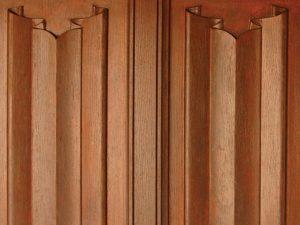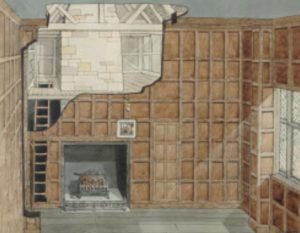Timber Wall Panelling:
Concealed Defects
Timber wall panelling often arouses suspicion among surveyors. What’s lurking behind the panels? Were the panels erected to hide a defect? It is very possible that the timber framework is in contact with a damp wall. Without ventilation behind the panelling, localised decay can occur. In today’s litigious society, most surveyors are understandably wary of receiving a claim for missing a defect such as this or of not making the client aware of the potential for a problem. They therefore tend to opt for a standard disclaimer. A typical disclaimer might read:
“In older buildings, walls were sometimes lined with timber panelling to hide dampness. The timber panelling prevented an inspection of the wall surfaces. Without carrying out exposure works, I am unable to provide further comment. If the supporting timbers are not adequately protected, and the intervening space not ventilated, serious forms of decay can develop.”
This is all very true and prudent; however, a deeper understanding of timber wall panelling and its history reveals that there is also a less sinister side to this internal cladding.
Hidden History
The original purpose of timber wall panelling was to provide a degree of thermal insulation to the home. Then, as with most things that start out with a utilitarian role, craftsmen began adding decorative elements. Initially, these were simple framed panels but gradually progressed to more elaborate designs such as linenfold. Linenfold is a type of carving applied to the panels which resembles folded linen and was popular in the 15th century.

linenfold panelling
Priest Holes
I recently conducted a Building Survey of a property constructed in 1706 (during the reign of Queen Anne, the last of the Stuart monarchs). The original full height Oak timber panelling was still in place within some of the principal rooms. As was the fashion at the time, the panelling was made up of relatively small rectangular panels. When this particular property was built, many ‘priest holes’ were also secretly created behind the timber wall panels of the grander houses. Priest holes served as hiding places for Catholic clergy to evade capture during times of persecution.
Regrettably, despite my best attempts at searching, I was unable to find a priest hole during this particular inspection.

A Typical Priest Hole
Classically Proportioned Wall Panelling
In the late 18th century, as the Stuart era transitioned into the reign of the Georgian monarchs, timber wall panelling became larger. The arrangement of the panelling also changed, influenced by the classical proportions found in Greek and Roman architecture.
Wainscoting
Later in the Georgian era, full height panelling began to fall out of favour. It was thought to give an oppressive feel to a room. A compromise was therefore to clad just the lower half of the wall in timber panelling. The upper portion of the wall had a plastered finish, with a profiled cornice at the junction with the ceiling. This new type of low-level panelling was called wainscoting – named after the slow-grown Oak trees imported from Germany or Russia.
A horizontal moulded rail was incorporated along the top of the wainscoting, known as a chair rail. So named because it prevented chairs (which were generally placed around the edges of a room rather than today’s arrangement of under the table) from damaging the panels.
The Commonplace Descendant of Timber Wall Panelling
In our modern era of standardized developer-built properties, we still have some traces of the grandiose panelling from the 16th and 17th centuries. However, it is on a much smaller scale and takes the form of simple MDF skirting boards. This is a stark contrast to the elaborate linenfold designs and wainscoting of the past, offering little in the way of concealment or historical charm.
Further related reading:
- Designs in Detail – This website provides an architect’s guide to wall panelling, discussing its practical benefits and aesthetic appeal in both traditional and modern settings.
- Vincent Reed – The History of Wooden Panelling Part 1: This extensive article offers a detailed exploration of the Tudor period as a turning point in British domestic architecture, with a focus on the evolution of oak panelling and its significance in Renaissance architecture.
- The Society for the Protection of Ancient Buildings (SPAB): This article provides practical advice on dealing with timber panelling, covering topics such as fungal decay, warping, repairs, and minimizing damage during removal.
- Wikipedia on Panelling: Offers a historical perspective on wainscoting, defining it as the inner wooden covering of a wall. This entry traces the origins and uses of wainscoting, providing a broad overview of its development and application.
- TheHandyBee – A Brief History of Wainscoting: This source explores the origins of wainscoting, its evolution from practical insulation to a decorative technique, and its various styles through history. It discusses how wainscoting became synonymous with elegance in modern times.



